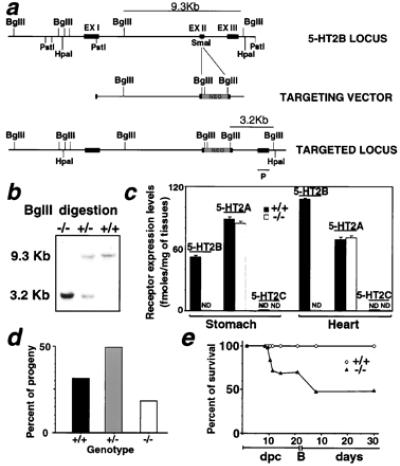Figure 1.

Targeted disruption of the 5-HT2B receptor gene. (a) (Top) The restriction map of the 5-HT2B receptor genomic locus of interest; (Middle) the targeting construct; and (Bottom) the mutated locus after homologous recombination. (b) The wild-type (+/+), heterozygous (+/−), and homozygous mutant (−/−) alleles were detected by Southern blot analysis. The probe (P) located outside of the construct detects a 9.3-kbp BglII fragment from wild-type DNA whereas it is reduced to 3.2-kbp in the homologous recombined allele. (c) The analysis of receptor membrane proteins by binding assay revealed a complete loss of 5-HT2B-specific sites in stomach and heart tissues of mutant mice. The maximal amount of binding sites is expressed as fmol specific binding/mg tissues ± SEM (n > 4). ND, no specific binding detected. (d) Genotyped progeny from 5HT2B +/− intercrosses showed that the homozygous genotype did not exhibit a Mendelian ratio, indicating some embryonic lethality among the homozygous. The percent of progeny is calculated from 120 newborn mice from 14 different litters. The homozygous mutant (−/−) (22 out of 120) represented 66% of the expected viable calculated, assuming sum of +/+ and +/− is 75%. (e) Percentage of homozygous survival before and after the birth in the progeny of heterozygous crosses. Before birth (B), the percent of survival is estimated from more than four litters of heterozygous crosses (n > 30), and a Mendelian ratio is observed until 10.5 dpc.
